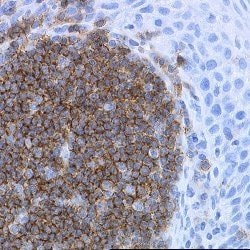Learn More
Invitrogen™ CD19 Monoclonal Antibody (LE-CD19)
Mouse Monoclonal Antibody
Supplier: Invitrogen™ MA181724
Description
Membrane permeabilization is required for flow cytometry applications. For FACS analysis, use 10 μL of the suggested working dilution to label 1x10^6 cells in 100 μL. A suggested positive control for immunohistochemical applications is tonsil. Mouse anti Human CD19 antibody, clone LE-CD19 recognizes an epitope within the C-terminal cytoplasmic tail sequence of human CD19, a single pass type I transmembrane glycoprotein containing two C2 type Ig-like domains in the N-terminal extracellular region and four potential phosphorylation sites for tyrosine together with a single serine in the cytoplasmic region.
CD19 is a member of the immunoglobulin superfamily and has two Ig like domains. The CD19 molecule is expressed on 100% of the peripheral B cells as defined by expression of kappa or lambda light chains. CD19 appears to be expressed on myeloid leukemia cells, particularly those of monocytic lineage. Leukemia phenotype studies have demonstrated that the earliest and broadest B cell restricted antigen is the CD19 antigen. The receptor for CD19 is an important functional regulator of normal and malignant B cell proliferation, and is expressed in all B cell precursor leukemias. Lymphocytes proliferate and differentiate in response to various concentrations of different antigens. The ability of the B cell to respond in a specific, yet sensitive manner to the various antigens is achieved with the use of low-affinity antigen receptors. CD19 is a cell surface molecule which assembles with the antigen receptor of B lymphocytes in order to decrease the threshold for antigen receptor-dependent stimulation. Besides being a signal-amplifying coreceptor for the B cell receptor (BCR), CD19 can also signal independently of BCR co-ligation and is a central regulatory component upon which multiple signaling pathways converge. Mutation of the CD19 gene results in hypogammaglobulinemia, whereas CD19 overexpression causes B cell hyperactivity.
Specifications
| CD19 | |
| Monoclonal | |
| 1 mg/mL | |
| PBS with 0.09% sodium azide; pH 7.4 | |
| P15391 | |
| Cd19 | |
| CD19 peptide CGPDPAWGGGGRMGTWSTR (C-Terminus) coupled to KLH (aa 539-556). | |
| 20 μg | |
| Primary | |
| Human | |
| Antibody | |
| IgG1 |
| ELISA, Flow Cytometry, Immunohistochemistry (Paraffin) | |
| LE-CD19 | |
| Unconjugated | |
| Cd19 | |
| AW495831; B4; B-lymphocyte antigen CD19; B-lymphocyte surface antigen B4; Cd19; CD19 antigen; CD19 molecule; CVID3; differentiation antigen CD19; Leu-12; T-cell surface antigen Leu-12 | |
| Mouse | |
| Protein A | |
| RUO | |
| 930 | |
| Store at 4°C short term. For long term storage, store at -20°C, avoiding freeze/thaw cycles. | |
| Liquid |
Safety and Handling
Your input is important to us. Please complete this form to provide feedback related to the content on this product.
